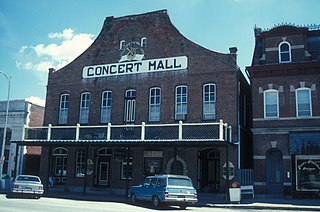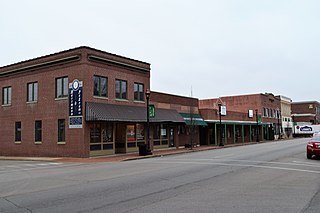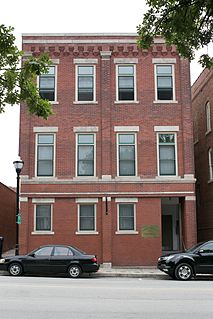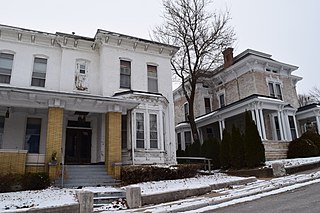
Downtown Columbia is the central business, government, and social core of Columbia, Missouri and the Columbia Metropolitan Area. Three colleges — the University of Missouri, Stephens College, and Columbia College — all border the area. Downtown Columbia is an area of approximately one square mile surrounded by the University of Missouri on the south, Stephens College to the east, and Columbia College on the north. The area serves as Columbia's financial and business district and is the topic of a large initiative to draw tourism, which includes plans to capitalize on the area's historic architecture and Bohemian characteristics. The downtown skyline is relatively low and is dominated by the 10-story Tiger Hotel, built in 1928, and the 15-story Paquin Tower.

The Walnut Street Historic District is a national historic district located at the northern end of Augusta, St. Charles County, Missouri. The District includes residential and commercial buildings constructed from the mid-19th to mid-20th centuries. Although there have been some minor modifications, the District appears as it did when the town was founded, and many buildings are still owned by descendants of German settlers. Located in the district is the separately listed Staudinger-Grumke House-Store.

Hermann Historic District is a national historic district located at Hermann, Gasconade County, Missouri. The district encompasses 360 contributing buildings, 4 contributing structures, and 3 contributing objects in the central business district and surrounding residential sections of Hermann. The district developed between about 1838 and 1910, and includes representative examples of Greek Revival and Classical Revival style architecture. Notable buildings include the Eitzen House (1855), Potnmer-Gentner House (1848), Hermann City Hall (1906), Strehly House (1845), Concert Hall (1877), The German School (1871), and Gasconade County Courthouse (1896).

The East Columbia Historic District is a national historic district located at Farmington, St. Francois County, Missouri. The district encompasses 11 contributing buildings in the central business district of Farmington. It developed between about 1879 and 1954, and includes representative examples of Late Victorian, Beaux Arts, and Bungalow / American Craftsman style architecture. Notable buildings include the Tetley Jewelry Store, Andy Hahn Building, Lang and Holler Building, U.S. Post Office, and Henry C. Meyer Building, and T.F. Lockridge Harness Co. Building / Wichman Nash Service.

The St. Charles Historic District is a national historic district located at St. Charles, St. Charles County, Missouri. It is the site of the first permanent European settlement on the Missouri River and of the embarkation of Lewis and Clark's journey of exploration along the Missouri. The first state capital of Missouri and over one hundred other historic buildings are located in the district.

Benton Avenue AME Church is a historic African Methodist Episcopal church located at 830 N. Benton Avenue in Springfield, Greene County, Missouri, USA. It was built between 1922 and 1926, and is a two-story tile block and brick church.

Walnut Street Commercial Historic District is a national historic district located at Springfield, Greene County, Missouri. The district encompasses seven contributing buildings in a commercial section of Springfield. The district developed between about 1895 and 1949, and includes representative examples of Italianate and Colonial Revival style architecture. Located in the district is the separately listed Landers Theater. Other notable buildings include the Masonic Temple (1906).

West Walnut Street Commercial Historic District is a national historic district located in Springfield, Missouri, United States. The district encompasses 14 contributing buildings in a commercial section of Springfield. The district developed between about 1888 and 1951, and includes representative examples of Italianate commercial architecture. Notable buildings include the Diffenderffer Building (1906), the Koenigsbruk and Boehmer Building, and the Grand Hotel / Springfield Seed Co. Building.

South–McDaniel–Patton Commercial Historic District is a national historic district located at Springfield, Greene County, Missouri. The district encompasses 12 contributing buildings in a commercial section of Springfield. The district developed between about 1872 and 1952, and includes representative examples of Late Victorian style architecture. Notable buildings include the Crenshaw Hardware Co. building, Rogers & Baldwin Hardware Co. building, John W. Williams Building, Queen City Meat Market building, and Phoenix Building.

Campbell Avenue Historic District is a national historic district located in Springfield, Missouri, United States. The district encompasses 11 contributing buildings in a commercial section of Springfield. The district developed between about 1885 and 1948, and it includes representative examples of Italianate and Colonial Revival style architecture. Notable buildings include the McLaughlin Block and Busy Bee Department Store.

Mid-Town Historic District is a national historic district in Springfield, Missouri, United States. It encompasses 455 buildings, 8 structures, and 7 objects in a predominantly residential section of Springfield. It developed between about 1871 and 1952, and includes representative examples of Late Victorian, Colonial Revival, and Bungalow / American Craftsman architecture, including the separately listed Bentley House and Stone Chapel. Other notable buildings include those on the Drury College campus, Central Christian Church (1926), St. Johns Episcopal Church (1886), Mary S. Boyd School (1911), and Trinity Lutheran Church.

Marx–Hurlburt Building are two historic commercial buildings located at Springfield, Greene County, Missouri. They were built about 1900, and are two- and three-story, rectangular Classical Revival style commercial buildings.

Wise Feed Company Building, also known as the Motor Mart Garage Building, is a historic commercial building located at Springfield, Greene County, Missouri. It was built about 1930, and is a two-story, rectangular tan brick commercial building. It has a flat roof and rests on a concrete foundation. It features decorative brickwork on the front facade.

College Apartments, also known as the Park Central Apartments, is a historic apartment building located at Springfield, Greene County, Missouri. It was originally constructed in 1910 as an expansion to Springfield Business College, and expanded and converted to apartments in 1928. It is a three-story, Commercial Block brick building with Classical details. The building features a flat parapet capped with flat limestone block and three brick pilasters with limestone capitals and plinths.

Edina Double Square Historic District is a national historic district located at Edina, Knox County, Missouri. The district encompasses 37 contributing buildings in the central business district of Edina. It developed between about 1865 and 1945 and includes representative examples of Italianate and Streamline Moderne style architecture. Notable contributing buildings include the Public Works Administration funded Knox County Courthouse (1934–1935) designed by William B. Ittner, Bishoff Bakery (1891), Northern Hotel (1860s), Ennis House/Northern Hotel, Edina School and Gymnasium (1915–1916), D. H. Mudd Building, Phillip Linville Building, Tobias J. Lycan Building, Jacob Pugh Building, Albert G. Bostick Building, Knox County Savings Bank, Thomas Burk Buildings, Bank of Edina Building, Joseph F. Biggerstaff Buildings, Stablein Building, and Knox County Public Library.

Maple Avenue Historic District is a national historic district located at Hannibal, Marion County, Missouri. The district encompasses 148 contributing buildings in a predominantly residential section of Hannibal. It developed between about 1850 and 1950, and includes representative examples of Federal, Italianate, Late Victorian, Colonial Revival, and Bungalow / American Craftsman architecture. Located in the district are the separately listed Ebert-Dulany House, Rockcliffe Mansion, and Eighth and Center Streets Baptist Church. Other notable buildings include Central School by William B. Ittner, Pilgrim Congregational Church, McKnight House, Cliffside, Hogg House, the McVeigh House, the Mclntyre House, the Settles House, and the Clayton House.

Neosho Commercial Historic District is a national historic district located at Neosho, Newton County, Missouri. The district encompasses 38 contributing buildings in the central business district of Neosho. It developed between about 1868 and 1943, and includes representative examples of Victorian and Modern Movement architecture. Notable buildings include the Newton County Courthouse (1936), Newton County Jail (1888), Haas Building (1906), First National Bank (1922), Auditorium and City Hall (1938), Masonic Lodge, and Newton County Bank (1884).

The Osage Farms Resettlement Properties in Pettis County, Missouri is a National Register of Historic Places multiple property submission located at Pettis County, Missouri. The submission includes 10 national historic districts and 2 individual properties listed on the National Register of Historic Places. The properties included were built by the Resettlement Administration / Farm Security Administration in 1937 as model farms and known as Osage Farms. Model farmsteads typically included a 1 1/2-story frame dwelling, barn, poultry house and privy.

The Sedalia Commercial Historic District is a national historic district located at Sedalia, Pettis County, Missouri. It encompasses 102 contributing buildings in the central business district of Sedalia. The district developed between about 1870 and 1959, and includes representative examples of Italianate, Romanesque Revival, and Art Deco architecture. Located in the district are the separately listed Hotel Bothwell, Building at 217 West Main Street, and Missouri/Sedalia Trust Company. Other notable buildings include the First United Methodist Church (1888-1891), Pettis County Courthouse (1924), Anheuser Busch Bottling Works, the New Lona Theater (1920), Citizens National Bank Building, Third National Bank (1929), Federal Building (1930), Montgomery Ward Building (1936), the Uptown Theatre (1936), Missouri Pacific Depot, and Central Presbyterian Church.

Sweet Springs Historic District is a national historic district located at Sweet Springs, Saline County, Missouri. The district encompasses 18 contributing buildings in the central business district of Sweet Springs. It developed between about 1875 and 1947, and includes representative examples of Queen Anne and Classical Revival style architecture. Notable buildings include the Sweet Springs Post Office (1912), McEntire & Son Jewelry/Post Office, Chemical Bank, and Barbee Lodge 217 AF&AM.
















